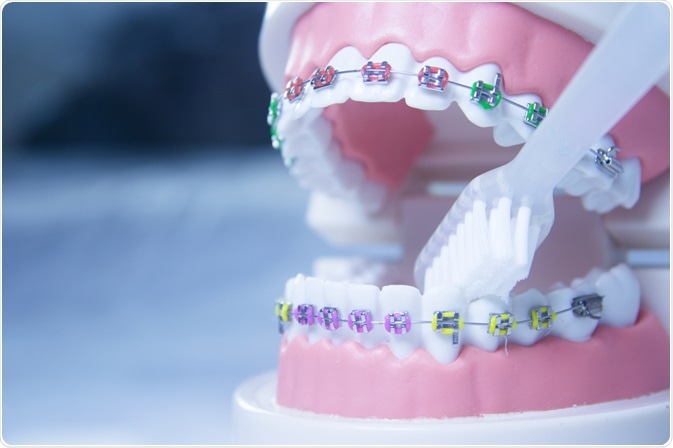Aarskog-Scott Syndrome (ASS), a rare developmental genetic disorder, is also known as faciogenital abnormality and is caused by a mutation in the X chromosome. It is mostly associated with males rather than females. This rare condition affects a person’s growth, as well as abnormalities of the genital area, the facial features, muscle, bone, and intellectual development.
 Image Credit: GemaIbarra / Shutterstock.com
Image Credit: GemaIbarra / Shutterstock.com
The type and extent of abnormality varies between individuals; for example, some may only have irregular facial features and stunted growth while some others may suffer from numerous aberrant aspects, depending on the extent of mutation.
Possible Treatment Plans for Aarskog-Scott Syndrome
Treatment is provided to improve the quality of life, as there is no permanent cure for this syndrome yet. Usually, symptoms are visible by the time the child is three years old, so treatment is started at this early stage so that patients can achieve a reasonable degree of normality as they grow older. Every patient with Aarskog syndrome needs an individual comprehensive therapy plan for treatment.
The peculiar abnormalities in the patient with their characteristic symptoms require the services of a specialist team of healthcare providers to provide a harmonized treatment.
- Facial and dental irregularities are corrected by orthodontic treatment.
- Surgical procedures are carried out to treat anomalies like cleft lip or palate and genital defects.
- Growth hormone (GH) treatment is given to correct growth retardation in stunted people.
- Auxiliary treatments are given to persons with intellectual deficiencies, including educational assistance
- Genetic counseling may be required for the parents.
Orthodontic Treatment for Aarskog-Scott Syndrome
This is a slow process that involves wearing of braces to shift the poorly arranged teeth into the desired alignment. The treatment procedure is the same as for any other orthodontic patient. Initially, the specialist fabricates the dental brackets according to dental pattern and then attaches the brackets to the teeth.
Parents need to take care of their child’s oral hygiene, prevent dental caries with a proper diet, and have regular follow-ups with the orthodontist, which is essential. After the teeth attain the proper position, they are further stabilized by retainers that hold the teeth in the altered position.
Surgeries for Aarskog-Scott Syndrome
Genital disorders like inguinal hernia and undescended testicles are treated with the help of surgery.
- Inguinal hernia repair surgery: This surgery is performed when the child is 12 months old. An internal opening in the inguinal canal located near the abdominal or belly wall is called the hernia orifice. Various abdominal structures may descend through this opening to form an inguinal hernia. A small incision is made on the abdomen through which the hernial sac is removed and the opening in the inguinal canal is closed by applying sutures.
- Cryptorchidism surgery: The condition in which either one or both the testicles have not dropped to their correct position in the scrotum is termed as cryptorchidism (undescended testicles). Surgery in this condition is usually performed in infants at 5-15 months of age. A small incision near the groin locates the testicles and a second incision in the scrotum is made to replace them in the proper location. Both the incisions are closed with biodegradable sutures.
- Cleft lip or palate surgery: This surgery is done within 12 months of the birth of the child. Here, the lip abnormality is repaired and the cleft closed through a surgical procedure. Presurgical procedures of lip repairing include:
- Improving the position of the maxillary alveolar arches by orthopedic treatment
- Performing nasoplasty if nasal deformity is present as well
- Cleft palate surgery: Submucous cleft palate is corrected only if the child has problems during feeding and speech activity. This surgery can be performed on a secondary level to correct the nasal tip deformity after the completion of nasal growth.
Growth Hormone Treatment in Aarskog-Scott Syndrome
GH is generally used to enhance the height of a person. Studies reveal that individuals who had ASS, when treated with GH, showed an increase in their height without any side effects. Here, selected doses of GH are administered for a period of six months to two years at specific intervals. However, some patients did not show any improvement in height even after receiving higher doses of GH.
Treatment of Eye Defects in Aarskog-Scott Syndrome
Some persons with ASS have defects in the eyes, which commonly result in strabismus and nystagmus.
Strabismus treatment: This condition refers to the irregular positioning of the eyes, which leads to improper vision. The treatment involves either:
- patching of the normal eye to attain normal vision in the lazy eye
- performing surgery to modify the eye muscles, so that they can move in a coordinated manner
Nystagmus treatment: An involuntary back-and-forth movement of the eyes is referred to as nystagmus. Glasses and contact lenses are used to treat this condition.
Auxiliary Treatments for Aarskog-Scott Syndrome
Some persons with ASS have a lowered intellectual capacity. Therefore, educational aids are provided to address their difficulties in learning. The aspects in which they have difficulty are reviewed regularly to enhance their mental abilities. Also, parents of the child with ASS are counseled about how to implement supportive treatment at home.
References
Last Updated: Jun 5, 2023